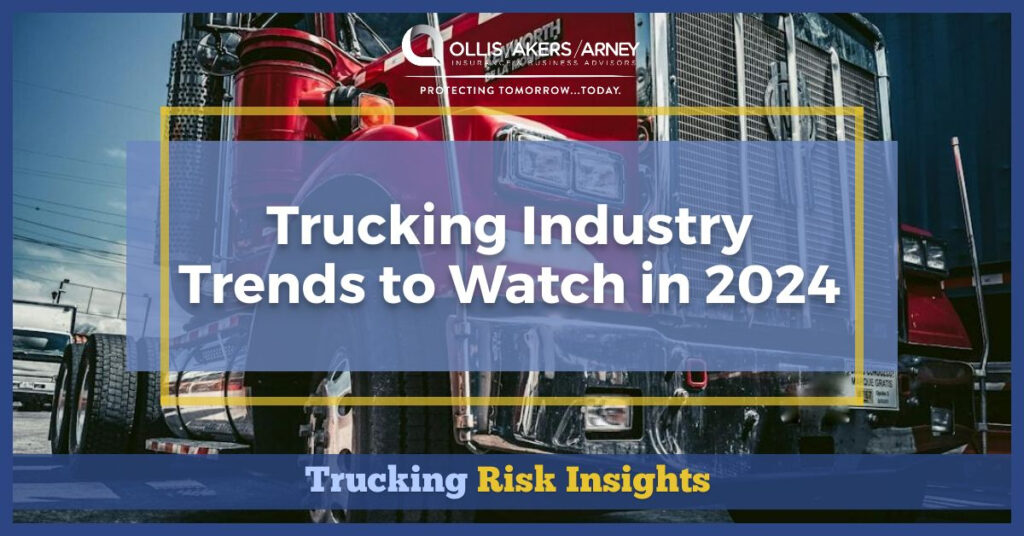Trucking industry conditions are constantly evolving, and businesses in the truck transportation subsector need to be aware of the changing landscape to maintain operational success. This year, trends that could impact the industry include economic challenges, driver shortages, social inflation contributing to rising commercial auto insurance rates, and utilizing electronic vehicles (EVs) in compliance with applicable regulations.
Each of these areas could significantly affect trucking businesses; as such, they must have a clear understanding of the latest sector developments and adjust their operations and risk management practices accordingly. This article provides more information on trucking industry trends to watch in 2024.
Economic Challenges
Driven by higher interest rates, inflation and rising operational costs, economic uncertainty continues to impact the trucking industry. These conditions have the potential to create lower consumer demand for goods and tighter margins for trucking businesses. Accordingly, trucking industry stakeholders who responded to the American Transportation Research Institute (ATRI) survey, conducted between Aug. 28 and Sept. 29, 2023, indicated that the economy was their top industry concern.
Consumers may opt to cut costs and purchase fewer goods during challenging economic times, which could reduce business across the trucking industry. As a result, trucking companies without substantial revenues, excess reserves and the additional capital necessary to offset extended periods of loss could be more likely to have to make difficult financial decisions, such as taking on more risk to reduce costs.
To prepare for economic volatility, trucking businesses should consider practices such as establishing concrete financial plans to withstand economic turbulence, scaling back certain operations to improve cost-effectiveness, promoting steady cash flow to ensure operations can remain viable amid changing economic conditions, ensuring proper debt management to reduce financial strain, fostering strong connections with stakeholders to maintain trust and loyalty, and leveraging effective marketing strategies to continue growing the business.
Driver Shortages
Labor shortages have been an issue for businesses of all sizes and sectors in recent years, and the trucking industry is no exception to this trend. According to the American Trucking Association’s chief economist, the sector is currently short 64,000 drivers; this number is expected to grow to 82,000 in 2030.
Making matters worse, a growing proportion of the trucking workforce is reaching retirement age, as the average age of truck drivers is in theor mid- to late 40s. This demographic shift could create further potential for driver shortages as more employees exit the industry.
The sector may be able to minimize labor concerns with the assistance of driverless commercial motor vehicles; however, this technology is not expected to become widely available for some time. As a result, trucking businesses should invest in their drivers and implement effective strategies to attract and retain workers.
Possible strategies to attract and retain drivers may include providing competitive wages and benefits; establishing workplace policies that foster a positive and inclusive culture; permitting flexible work arrangements (if possible); leveraging digital platforms in the recruitment process to increase the number of candidates; and offering ample professional development resources (e.g., training and mentorship programs). Additionally, trucking businesses should consider exploring unrepresented demographics to help expand their talent pools.
Social Inflation
Social inflation generally refers to societal trends that influence the rising costs of insurance claims and lawsuits above the overall inflation rate. One of the main factors driving current social inflation issues is the ongoing increase in nuclear verdicts (jury awards exceeding $10 million), especially within the trucking sector.
Trucking businesses have become more likely to face such verdicts because their commercial drivers and fleets are increasingly held responsible for accidents causing third-party property damage, injuries or fatalities. According to the ATRI, the size of verdict awards grew by 51.7% annually from 2010 to 2018. Additionally, A 2022 study by the Insurance Information Institute and the Casualty Actuarial Society found that social inflation was responsible for $20 billion in commercial auto liability claims between 2010 and 2019.
Along with a shifting legal environment in which underwriters are responding with increased risk management requirements, these trends have prompted a surge in the cost of commercial auto claims across the trucking industry. This has ultimately led to higher insurance rates and decreased insurance availability.
Amid rising social inflation issues, it is crucial for trucking businesses to make safety a top priority among their commercial drivers and fleets and take steps to prevent accidents on the road. This may reduce the likelihood of accidents, lawsuits, nuclear verdicts and increased insurance costs. Valuable accident prevention measures may include enforcing routine fleet inspection protocols to identify and remediate vehicle safety risks; adhering to strict driver hiring protocols and enhancing driver safety programs to emphasize safety; using of vehicle technology (e.g., telematics) to monitor driving behaviors; rewarding drivers for upholding safe behaviors behind the wheel; establishing accident reporting and response procedures to ensure issues are recorded and swiftly addressed; and following an accident review process to address remaining exposures.
EV Compliance and Risks
With many federal and state governments pushing for lower carbon dioxide roadway emissions, trucking businesses must comply with applicable regulations. For example, the U.S. Environmental Protection Agency (EPA) recently finalized national clean air standards to cut smog- and soot-forming emissions from heavy-duty trucks starting with model year 2027. The new standards, the first update to clean air standards for heavy-duty trucks in over 20 years, are more than 80% stronger than current standards. The EPA estimates that these regulations will result in:
- Up to 2,900 fewer premature deaths
- 6,700 fewer hospital admissions and emergency department visits
- 18,000 fewer cases of childhood asthma
- 3.1 million fewer cases of asthma symptoms and allergic rhinitis symptoms
- 1.1 million fewer lost school days for children
- 78,000 fewer lost workdays
- $29 billion annual net benefits
EVs will play a large role in these new standards as trucking companies evolve to meet sustainability initiatives and meet applicable requirements. For example, the EPA has granted California the legal authority to require half of all heavy-duty truck sales in the state to be fully electric by 2035.
Although there are numerous environmental and health benefits from EV use, there are also risks and concerns that trucking businesses need to address. Because EVs offer connected car technologies such as Wi-Fi, data sharing and semi-autonomous systems, they may be vulnerable to cyberthreats. Public charging stations may also serve as an entry point for malware attacks, data theft, system outages, bugs and glitches. Additionally, EV battery manufacturing defects can lead to large-scale vehicle recalls, putting fleet owners at an increased risk of business delays. Under certain conditions, lithium-ion batteries that power EVs can even ignite or explode with fires that release toxins. Other concerns include the scarcity of repair EV shops and parts, the risks to pedestrians due to quieter vehicle operation, costlier repairs, the impact of weather on battery performance, and hazards from the high-voltage electric cables that run throughout the body of EVs.
To prepare for the transition to EVs, trucking businesses should assess their operations and applicable regulations. Proper planning is necessary to ensure financial stability through this change. Additionally, trucking businesses should conduct regular training on how to safely operate and maintain EVs and evaluate their routes to ensure sufficient battery life to meet destinations. Proper insurance is also essential, as it may cover potential liabilities and vehicle damage arising from EV use.
Conclusion
There are several trends already impacting the trucking sector this year. By staying on top of these developments and taking steps to mitigate their associated exposures, trucking businesses can effectively position themselves to maintain long-term growth and operational success.
Contact us today for additional industry resources and risk management guidance.
This Risk Insights is not intended to be exhaustive nor should any discussion or opinions be construed as legal advice. Readers should contact legal counsel or an insurance professional for appropriate advice. © 2024 Zywave, Inc. All rights reserved.


